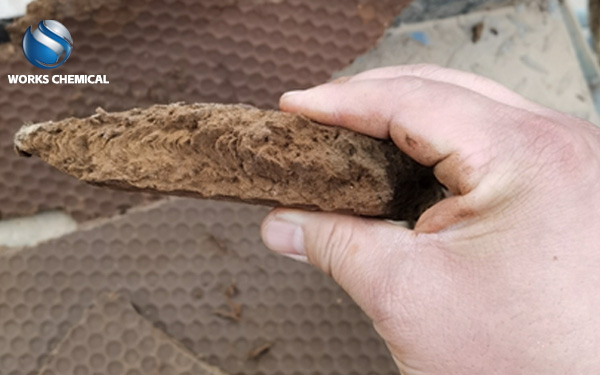
Sludge synergist has a remarkable effect in solving the problem of "runny yolk" in mud cake. The following is a detailed analysis of how sludge synergists solve the "runny" problem of mud cakes:

First, the mechanism of action of sludge synergists
Sludge enhancer is a chemical agent used to improve the dewatering performance of sludge, which can improve the dewatering effect of sludge through a variety of mechanisms, so as to avoid the "runny" phenomenon of mud cake. Specifically, sludge synergists can chemically react with organic substances and colloidal particles in the sludge to generate sediments or promote the agglomeration of particles, thereby changing the particle distribution and surface properties of the sludge. These changes help to reduce the adhesion of sludge, improve its solid-liquid separation performance, and make it easier to form mud cake with tight structure and low water content during the dewatering process.
Second, the improvement effect of sludge synergist on the "runny" problem of mud cake
Improve the size and thickness of mud cake: Sludge enhancers can significantly improve the dryness and thickness of mud cake because they can promote better separation of water in the sludge to form a drier mud cake. This helps to reduce the "runny" part of the mud cake, making the mud cake more even and firm overall.
Shortening dewatering time: Because sludge enhancers can improve the dewatering performance of the sludge, they can shorten the dewatering time and reduce the energy consumption and treatment time of the dewatering equipment. This helps to improve dewatering efficiency, reduce operating costs, and reduce the "runny" problem of mud cakes caused by prolonged dewatering.
Improve the quality of the filtrate: The use of sludge enhancers can also improve the quality of the filtrate and reduce the suspended matter and metal content in the filtrate. This helps to reduce the tendency of the filtrate to corrode and scale the equipment, extend the service life of the equipment, and reduce the pollution to the environment.
3. Use cases of sludge synergists
In practical applications, sludge enhancers have successfully solved sludge dewatering problems in many fields. For example, in municipal sewage treatment plants, the use of sludge synergists instead of traditional conditioners such as polyacrylamide (PAM) and polyaluminum chloride (PAC) not only reduces operating costs, but also improves the efficiency and quality of dehydration. Specifically, after the use of sludge synergist, the amount of mud into the plate and frame filter press increases, the thickness of the mud cake increases, the moisture content decreases, and the difference in internal and external dryness is small, and there is no "runny" mud cake phenomenon.
4. Precautions
When using sludge synergists, the following points need to be noted:
Choose the right agent: Different types of sludge and water quality may require different types of sludge enhancers. Therefore, in the selection of agents need to be tested and compared according to the actual situation, choose the most suitable agent.
Determine the appropriate addition ratio: In order to ensure the best use of sludge synergists, it is necessary to determine the appropriate addition ratio through a small test. Adding too much or too little can result in poor dehydration or wasted agents.
Pay attention to the safety of storage and use: sludge synergists are generally chemical agents, and need to be stored in a cool, dry, ventilated place to avoid direct sunlight and high temperatures. Wear protective equipment when using and avoid direct contact with skin and eyes.
To sum up, the sludge synergist has a significant effect in solving the problem of "runny" mud cake. By selecting the appropriate reagent, determining the appropriate proportion of addition and paying attention to the safety of storage and use, the role of sludge synergists can be fully played to improve the efficiency and quality of sludge dewatering.